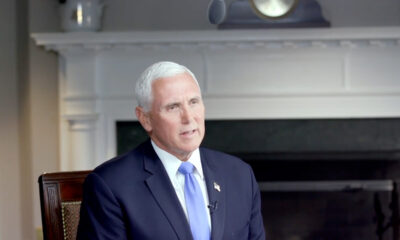Education
The Upstart ‘Classic Learning Test’ Gets a Testy Welcome From the SAT
The CLT (Classic Learning Test) is a new standardized test that emphasizes classical learning and is available to home schoolers.

A lobbyist for the College Board delivered a sharp warning to William Slater last month. She was not happy that the Tennessee Republican lawmaker had recently introduced a bill to allow the state’s public universities to accept the Classic Learning Test, an upstart competitor to the College Board’s famed SAT, as an admissions exam.
The CLT spooks the College Board
The lobbyist aimed to kill the bill.
“She let me know that the College Board is opposed and indicated that she will be speaking with each member of the higher education subcommittee,” Slater told RealClearInvestigations. “I told her it seems protectionist and I’m not going to allow a monopoly to keep us from doing good education policy in Tennessee.”
Tennessee is just one of the states where the College Board, a nonprofit with $1 billion in annual revenue, is trying to stop the expansion of the Classic Learning Test (CLT), run by a small company with about $10 million in revenue. While the College Board justifies its attack with criticism of the test’s quality – claims CLT leaders reject – underlying the controversy appears to be a fierce competition for market share.
The battle over the CLT also reflects the profound forces transforming K-12 education. As growing numbers of Americans seek alternatives to traditional public education, an infrastructure of charter, private, and home schools has expanded to support them. The CLT, which grew out of the classical education movement, is a recent addition to that infrastructure, a bridge between high school and college.
“The CLT is another option for students that tests a different aspect of education,” said Chester Finn, an expert on assessments and president emeritus at the Thomas B. Fordham Institute. “It has merit as a test for college admissions.”
How the SAT and ACT have failed American education
For decades, the College Board’s SAT and its chief rival, the ACT (which was bought last year by a private equity firm), have dominated the college admissions market. They are not simply exams – they are touchstones of academic achievement that have extraordinary influence on education, giving shape to what students study in school and strive for in life. High-performing schools display their students’ SAT and ACT scores online as a badge of honor.
As CLT founder Jeremy Tate sees it, those tests have played a role in making education overly utilitarian and job-focused. It has lost its soul, leaving students bored and uninspired with learning, says Tate, a former public school teacher in New York City. He is not surprised at all that public education is afflicted with sky-high absenteeism and record low achievement.
Tate is a central figure in an educational revival that aims to restore some of the wonder in learning. The great books of Western civilization and a focus on big questions of virtue and justice form the centerpiece of classical instruction. Science, math, and technology are important, too, but as pieces within the broader classical approach.
CLT already making a good impact
Educators of all political stripes, from conservative Hillsdale College President Larry Arnn to progressive philosophy professor Cornel West, are promoting classical Christian and secular charter schools that number in the hundreds. They were the early adopters of the CLT because of its emphasis on classical works, and the test has recently spread into traditional public schools, serving at times as a catalyst for change.
“In schools that are not already classical, we commonly see some curricular impact after adopting the CLT, like the addition of philosophy or grammar,” said Tate, a graduate of the Reformed Theological Seminary. “We need to get back to the ancient goal of the cultivation of virtue, and the CLT is part of that.”
A Battle for Market Share
Tate decided to create the CLT while he was running an SAT and ACT test prep company. Those exams are based on the Common Core standards popular in public education but not in the private and home schools where he prepped students for the tests. So, in 2015, he developed the CLT, a two-hour verbal, grammar, and quantitative exam, more aligned to the classical education of his students.
Over the next eight years, the number of CLT test takers was de minimis. Although more than 200 colleges agreed to accept CLT scores for admission, they were almost all small religious schools, significantly limiting the test’s appeal to students.
The CLT broke out of its religious bubble in 2023 when Florida became the first state to approve its use in high schools and public universities. The test suddenly became a more serious player in the market, firing a shot across the bow of the College Board.
Thanks to Florida, the number of CLT test takers soared seven-fold to 182,000 last year. The biggest surprise was that the surge in Florida came mostly from public school students, evidence of the CLT’s broadening appeal.
CLT gains market share; Florida is only the first State
The CLT’s market share is still a far cry from the leading SAT’s 1.97 million test takers and ACT’s 1.4 million for the class of 2024. But Florida made clear that the CLT could become a real competitive threat if more states sign on.
“There is no doubt that the CLT is taking market share from the SAT and ACT in Florida,” said Doug Tuthill, the chief vision officer at Step Up For Students, which runs the state’s school choice scholarship programs.
Now, as Arkansas, Iowa, Oklahoma, Tennessee, and Texas consider CLT legislation, the College Board is moving to stop the momentum. It has deployed lobbyists to the state capitols to block the bills for reasons that it posted in a brief on its website in May: “New external research shows that the CLT is not predictive of college performance or success and has no relationship to student outcomes.” That’s a damning assessment since the very purpose of a college admissions test is to predict how students will perform.
“New external research” – that’s a lie
CLT leaders say the College Board’s assertion is false. To date, there is no completed research that addresses the predictiveness of the CLT. It remains a question to be answered. Last year, Tate’s company began a longitudinal study – tracking the same students over a long period – to determine the CLT’s predictive power, and the results are not in yet.
“Absolutely the College Board is trying to undermine the CLT,” Tate said. “It’s part of a duopoly and so it makes sense that they don’t want to have competitors in the space.”
The College Board denies that its criticism of the CLT is based on a desire to protect its market share. The nonprofit says its mission is to help students succeed in college, and it supports having a diversity of tests provided they are backed by research. “The College Board believes that students should be able to choose from any research-backed test that allows them to effectively show what they know and can do,” Holly Stepp, executive director of media relations, told RCI.
Classical Education’s Appeal
Like the SAT, the CLT is a multiple-choice test of literacy and numeracy. But the two tests differ significantly when it comes to reading content. This difference became more pronounced last year when the College Board rolled out the digital SAT in the U.S., calling it more student-friendly and less stressful.
The digital SAT is partly a response to the large number of colleges that have become test-optional, posing a challenge to the CLT and ACT, too. With an eye on preserving market share, the College Board said its goal is for the digital SAT to be the only test that students take.
In addition to cutting the SAT testing time to 2 hours and 14 minutes, the reading passages have been significantly shortened to between 25 and 150 words. The College Board said the shorter passages are a better fit for the digital format and are just as challenging. The brief passages also seem to nod at social media, which has transformed how students consume information.
CLT leaders say the SAT’s new approach demands less thoughtfulness from students. The CLT’s longer passages of 525 words are drawn from classic works in history, literature, science, philosophy, and religion. A practice CLT test features the Epic of Gilgamesh, St. Teresa of Avila, and James Madison. Tate says the readings make the test engaging and meaningful and will attract more students.
A school that swears by the CLT
Veritas, a classical Christian K-12 academy in St. Augustine, FL, is a true believer in the CLT. The test is more aligned to the school’s rigorous program that includes Homer in middle school before Shakespeare and Dostoevsky in later grades, says Andrew Smalley, the head of school.
Veritas intentionally gives students difficult works that have stood the test of time to inspire them to rise to the challenge of tackling the question of what it means to be human. “This is far superior to other approaches where kids are not being pushed academically and they are just checking boxes on tests that are kind of meaningless to them,” said Smalley, a member of the CLT’s board of academic advisers.
As crazy as it sounds, Smalley says, most of his students are excited to take the CLT because they find the content interesting. Veritas uses it both to meet a state requirement that private schools test students and for college admissions, along with the SAT and ACT. All members of Veritas’ small class of 2025 have earned a college acceptance.
“A student walked out of the CLT and told me it had a passage from a beautiful poem that she now had to read,” said Smalley. “Students don’t normally say something like that after taking a standardized test. It’s because the CLT validates deeper thinking.”
Obstacles to CLT’s Expansion
The CLT’s attempt to expand across the country presents a daunting challenge. Tate’s company of about 50 employees must convince state lawmakers and boards of governors to change their laws and rules to include the CLT on the menu of tests that serve K-12 schools and public universities.
“Most state lawmakers have never heard of the CLT, or if they have, they don’t realize they need to make policy changes so students can take the test for state university admissions,” said Michael Torres, CLT’s legislative director. “It’s definitely a big education hurdle but there is significant interest from lawmakers.”
What’s more, for over half a century, the SAT and ACT have cemented their positions in state law as the gold standard of tests, providing a technically complex service that’s hard for newcomers to match without a team of PhDs and ample resources for research studies and lobbying.
The College Board also has been adept at maintaining the SAT’s position as the No. 1 college entrance exam, spending $830,000 on lobbying in 2023. It famously won a state testing contract in Michigan in 2015 with a low bid that was about half the amount of ACT’s losing offer.
College Board and ACT fight their own share war
“The College Board’s aggressive play for market share didn’t help students in Michigan,” said Richard Phelps, a standardized testing expert and former policy research director at ACT. “Schools had been prepping students for years for the ACT and now they had to throw all of that away and start over again with the SAT. It was a mess.”
The CLT’s victory in Florida, where the College Board has 10 lobbyists, was a matter of political good luck. During Republican Gov. Ron DeSantis’ presidential bid, he attacked the College Board over what he considered its woke AP African American studies course. During the high-profile fight, DeSantis’ office contacted Tate’s company to request that it bring the CLT to Florida to compete with the College Board. Soon after, state lawmakers and the board of governors approved the CLT.
“We were told that the support for the CLT came directly from the governor,” Tate says. “We didn’t have a lobbyist in Florida.”
The College Board locks onto a new target
The CLT’s success in Florida stirred controversy with the College Board. Working under a tight deadline set by Florida, Tate’s company produced a study called a “concordance” designed to show how CLT and SAT scores align with each other. The study is essential for admissions officers to compare the performance of students who take different tests. But it has become another target of the College Board’s attack on the CLT to prevent other states from adopting it.
The College Board’s brief says the study is invalid because of several technical issues, including the claim that the sample of students wasn’t representative. Eren Asena, a CLT statistical analyst who worked on the study, provided a detailed rebuttal of all the College Board criticisms in an interview. But Tate’s company says it didn’t publish a rebuttal, which would allow independent experts to evaluate the critique of the CLT, to avoid a distracting tit-for-tat argument with the College Board.
Iowa Rejects the CLT
The dispute has been a drag on the CLT’s growth. Last year, the Iowa Board of Regents considered a proposal to include the CLT in its automated admissions process for the state’s universities. But the board rejected the proposal, citing the College Board’s “legitimate concerns about the validity of CLT concordance tables related to the SAT.” The board’s researchers say they didn’t contact Tate’s company to hear its side of the story.
Iowa Regent David Barker, a former economist at the Federal Reserve Bank of New York, told RCI that the CLT should have been approved. It would have attracted more home-schooled students to Iowa’s universities at a time of fluctuating enrollment.
Did Iowa’s Regents forget whom they served?
Barker found the study to be valid partly because “there is plenty of data to make a strong concordance.” But he says the College Board’s opposition to the CLT, which influenced the board, didn’t surprise him. “Whether they are for-profit or non-profit, I expect them to look out for their own interests. But it’s the job of the regents to see through that and make appropriate choices,” said Barker, adding that the board could consider the CLT again.
Amid the quarrel over the concordance, representatives from CLT, the College Board, and ACT held a series of meetings to begin a collaboration on a more robust study that all parties could agree on, says CLT’s Chief Financial Officer Noah Tyler. They were following a precedent in 2018 when the College Board and ACT collaborated on a study after publicly feuding over a concordance.
But the collaboration with CLT ended in September after a College Board executive told Tyler that the organization was too busy to continue. “Something dramatically shifted in the College Board’s motivation to do a joint concordance,” Tyler said. “But we don’t know why.”
More States Consider the CLT
This year, a wave of CLT bills has emerged in school choice-friendly states following Florida’s lead. College Board lobbyists have also appeared to bat them down.
Lawmakers in Arkansas, Iowa, Tennessee, and Texas introduced legislation to add the CLT to their list of university admissions tests. Oklahoma’s more modest measure, which passed in its House on Tuesday and now goes to the Senate, would allow students to qualify for state scholarships using a CLT score and is seen as a first step to requiring universities to accept the test for admissions.
Oklahoma Republican lawmaker Toni Hasenbeck says she sponsored the CLT bill in support of families that are choosing educational alternatives such as homeschooling. She says these students are already taking the CLT for private college admissions and shouldn’t have to also take the SAT or ACT for a state scholarship.
Soon after introducing her bill, Hasenbeck told RCI that she heard from a College Board lobbyist. He had written a long letter to the state superintendent criticizing several aspects of the CLT, including its concordance study.
“I told the lobbyist that the letter was very aggressive and I didn’t appreciate it,” said Hasenbeck, whose bill will face a House floor vote. “I’m willing to have a conversation. But when people push in that way, I’m very resistant to changing my bill. We will see what happens.”
Attracting home-schooled students
Hasenbeck, who has seen the benefits of standardized testing from two decades in public education, says she realizes the CLT has a short track record. But she says the benefits of increasing the number of home-schooled students who are assessed outweigh the risks of using a relatively new test.
State wins are essential for Tate to reach his goal of 500,000 annual CLT test-takers in three years, or more than twice the 2024 number. By his logic, as the number of CLT students grows, selective private universities will eventually also come on board because they want more applicants to keep their admissions rate low.
“I think people know that we need disruption in this testing market, that the College Board needs to be challenged,” said Tate. “And we have a lot of grassroots enthusiasm behind the CLT that’s helping us make some big gains.”
This article was originally published by RealClearInvestigations and made available via RealClearWire.
Vince Bielski is a self-employed free-lance journalist. His favorite subjects are the environment, green energy, education, and immigration.
-

 Civilization3 days ago
Civilization3 days agoDC Pipe Bomb Arrest Raises Questions About Christopher’s Wray’s FBI
-

 Civilization4 days ago
Civilization4 days agoThe Legal Logic Behind U.S. Operations Against Narco-Terrorist Networks
-

 Guest Columns5 days ago
Guest Columns5 days agoCongressional Leaders See Far Higher Stock Returns Than Peers
-

 Civilization5 days ago
Civilization5 days agoHow Trump Changed America
-

 Executive4 days ago
Executive4 days agoNewsom’s ‘National Model’ for Homeless Wracked by Fraud
-

 Executive3 days ago
Executive3 days agoWhen You’re in a Hole, Stop Digging
-

 Education2 days ago
Education2 days agoWaste of the Day: Taxpayers Subsidize Football Coach Severance
-

 Civilization2 days ago
Civilization2 days agoPence Calls on Trump To Fire RFK Jr Over Abortion Drug












